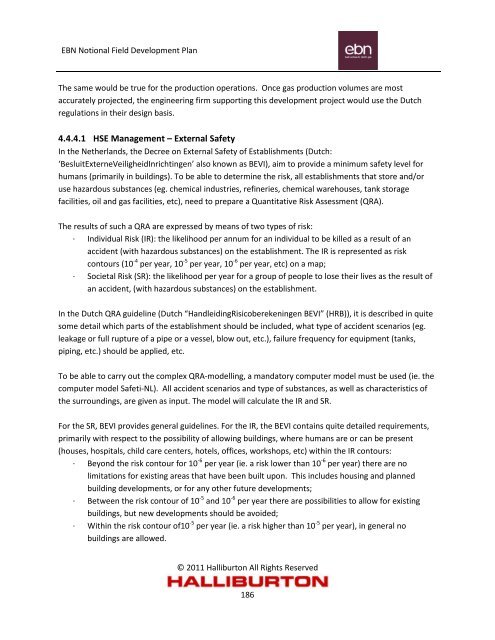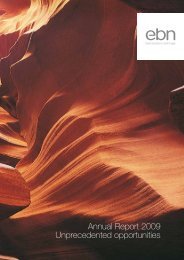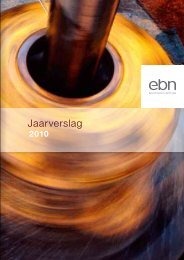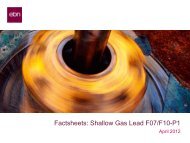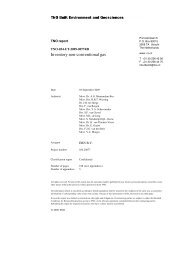Notional Field Development Final Report - EBN
Notional Field Development Final Report - EBN
Notional Field Development Final Report - EBN
You also want an ePaper? Increase the reach of your titles
YUMPU automatically turns print PDFs into web optimized ePapers that Google loves.
<strong>EBN</strong> <strong>Notional</strong> <strong>Field</strong> <strong>Development</strong> Plan<br />
The same would be true for the production operations. Once gas production volumes are most<br />
accurately projected, the engineering firm supporting this development project would use the Dutch<br />
regulations in their design basis.<br />
4.4.4.1 HSE Management – External Safety<br />
In the Netherlands, the Decree on External Safety of Establishments (Dutch:<br />
‘BesluitExterneVeiligheidInrichtingen’ also known as BEVI), aim to provide a minimum safety level for<br />
humans (primarily in buildings). To be able to determine the risk, all establishments that store and/or<br />
use hazardous substances (eg. chemical industries, refineries, chemical warehouses, tank storage<br />
facilities, oil and gas facilities, etc), need to prepare a Quantitative Risk Assessment (QRA).<br />
The results of such a QRA are expressed by means of two types of risk:<br />
· Individual Risk (IR): the likelihood per annum for an individual to be killed as a result of an<br />
accident (with hazardous substances) on the establishment. The IR is represented as risk<br />
contours (10 -4 per year, 10 -5 per year, 10 -6 per year, etc) on a map;<br />
· Societal Risk (SR): the likelihood per year for a group of people to lose their lives as the result of<br />
an accident, (with hazardous substances) on the establishment.<br />
In the Dutch QRA guideline (Dutch “HandleidingRisicoberekeningen BEVI” (HRB)), it is described in quite<br />
some detail which parts of the establishment should be included, what type of accident scenarios (eg.<br />
leakage or full rupture of a pipe or a vessel, blow out, etc.), failure frequency for equipment (tanks,<br />
piping, etc.) should be applied, etc.<br />
To be able to carry out the complex QRA-modelling, a mandatory computer model must be used (ie. the<br />
computer model Safeti-NL). All accident scenarios and type of substances, as well as characteristics of<br />
the surroundings, are given as input. The model will calculate the IR and SR.<br />
For the SR, BEVI provides general guidelines. For the IR, the BEVI contains quite detailed requirements,<br />
primarily with respect to the possibility of allowing buildings, where humans are or can be present<br />
(houses, hospitals, child care centers, hotels, offices, workshops, etc) within the IR contours:<br />
· Beyond the risk contour for 10 -6 per year (ie. a risk lower than 10 -6 per year) there are no<br />
limitations for existing areas that have been built upon. This includes housing and planned<br />
building developments, or for any other future developments;<br />
· Between the risk contour of 10 -5 and 10 -6 per year there are possibilities to allow for existing<br />
buildings, but new developments should be avoided;<br />
· Within the risk contour of10 -5 per year (ie. a risk higher than 10 -5 per year), in general no<br />
buildings are allowed.<br />
© 2011 Halliburton All Rights Reserved<br />
186


